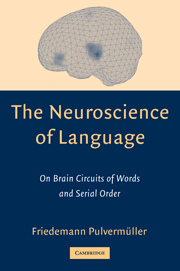Book contents
- Frontmatter
- Contents
- Preface
- The Neuroscience of Language
- 1 A Guide to the Book
- 2 Neuronal Structure and Function
- 3 From Classic Aphasia Research to Modern Neuroimaging
- 4 Words in the Brain
- Excursus E1 Explaining Neuropsychological Double Dissociations
- 5 Regulation, Overlap, and Web Tails
- 6 Neural Algorithms and Neural Networks
- 7 Basic Syntax
- 8 Synfire Chains as the Basis of Serial Order in the Brain
- 9 Sequence Detectors
- 10 Neuronal Grammar
- 11 Neuronal Grammar and Algorithms
- Excursus E2 Basic Bits of Neuronal Grammar
- Excursus E3 A Web Response to a Sentence
- 12 Refining Neuronal Grammar
- Excursus E4 Multiple Reverberation for Resolving Lexical Ambiguity
- Excursus E5 Multiple Reverberations and Multiple Center Embeddings
- 13 Neurophysiology of Syntax
- 14 Linguistics and the Brain
- References
- Abbreviations
- Author Index
- Subject Index
13 - Neurophysiology of Syntax
Published online by Cambridge University Press: 15 December 2009
- Frontmatter
- Contents
- Preface
- The Neuroscience of Language
- 1 A Guide to the Book
- 2 Neuronal Structure and Function
- 3 From Classic Aphasia Research to Modern Neuroimaging
- 4 Words in the Brain
- Excursus E1 Explaining Neuropsychological Double Dissociations
- 5 Regulation, Overlap, and Web Tails
- 6 Neural Algorithms and Neural Networks
- 7 Basic Syntax
- 8 Synfire Chains as the Basis of Serial Order in the Brain
- 9 Sequence Detectors
- 10 Neuronal Grammar
- 11 Neuronal Grammar and Algorithms
- Excursus E2 Basic Bits of Neuronal Grammar
- Excursus E3 A Web Response to a Sentence
- 12 Refining Neuronal Grammar
- Excursus E4 Multiple Reverberation for Resolving Lexical Ambiguity
- Excursus E5 Multiple Reverberations and Multiple Center Embeddings
- 13 Neurophysiology of Syntax
- 14 Linguistics and the Brain
- References
- Abbreviations
- Author Index
- Subject Index
Summary
Models are only as good as the tools available for testing them. Is there any perspective on testing the proposals about syntactic brain processes discussed to this point?
Making Predictions
One obvious prediction of the neuronal grammar framework is that the cortical processes following a sentence in the input are of different types. Such process types include the following:
Ignitions of word webs
Ignitions of sequence sets
Downward or upward regulation of activity by threshold control
Reverberation and priming of neuronal sets
It may be possible to investigate these putative processes using neurophysiological recording techniques. Because the relevant activation and deactivation processes likely occur within tenths or hundredths of a second, it is advisable to use fast neuroimaging techniques in the investigation of serial-order information processing.
At first glance, one straightforward way of transforming any of the mentioned simulations into predictions about neurophysiological processes appears to be by calculating sum activity values at any time step of a simulation, and by thereby obtaining a series of activity values.
However, this strategy is not so straightforward as it appears at first glance because several parameters must be chosen beforehand. The relative weighting of the activity states is one set of parameters that appears to distinguish between pronounced activity changes – those induced by ignitions and regulation processes – and smaller ones – as, for example, those caused by the spreading of priming or reverberation. As an additional set of parameters, the time constants of individual processes must be specified.
- Type
- Chapter
- Information
- The Neuroscience of LanguageOn Brain Circuits of Words and Serial Order, pp. 265 - 269Publisher: Cambridge University PressPrint publication year: 2003



